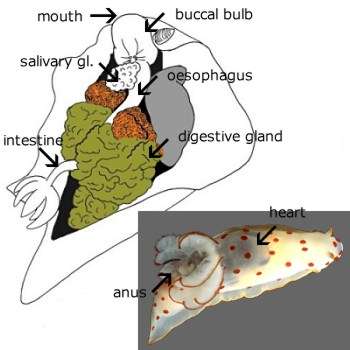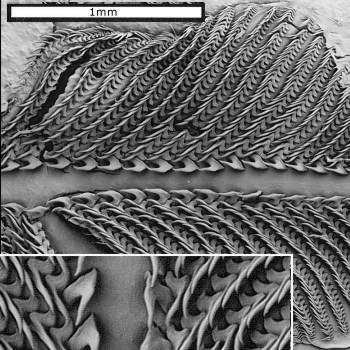

Digestive system of a dorid nudibranch
The best way to describe how the digestive system works in sea slugs is to describe a few examples. This is Gymnodoris ceylonica, a carnivorous hunter which Scott Johnson reports feeding on the small sea hare Stylocheilus. The structure and function of its gut is typical of most dorid nudibranchs, although there are slight modifications for feeding on different sorts of prey.
Have a look at the page on the dorid head to see where the mouth is and how they search for their prey. Inside the mouth is the muscular buccal bulb which contains the radula which is a ribbon of precisely arranged teeth used for scraping or grasping their food. A slug's teeth are not in jaws like us but on a flexible tongue. The bottom photo shows the radular ribbon of Gymnodoris removed from the buccal bulb and flattened out for easy viewing.
Most sea slugs have salivary glands which secrete digestive juices into the buccal bulb to help start the digestive process.
From the buccal bulb the food moves back through a tube called the oesophagus to the stomach, which in dorids is usually a fairly small chamber, with ducts leading off to the digestive gland.
If you look at the picture of Gymnodoris you will see a large black shadow in the body in front of the gills. This is the digestive gland. The arrow seems to be pointing to this, but is in fact pointing to the thin-walled heart which lies over the top of it. The digestive gland is a very important organ in all molluscs (snails, slugs, clams, octopus etc). It is the organ which produces most of the digestive enzymes, it absorbs all the nutrients, and excretes all the waste products. It does all the work of the stomach, intestine, and liver in humans.
Waste products, both non-food particles, which stay in the stomach and are not sent to the digestive gland, and waste material excreted by the digestive gland, are compacted into faecal pellets and travel through the intestine to the anus. In dorid nudibranchs, the anus is found in the centre of the gills. This may seem to be a strange place to deposit their faeces but have a look at the pages on Torsion and Detorsion which explain how snails became slugs and how their bodies changed as the shell was lost.
Authorship detailsRudman, W.B., 2000 (March 16) Digestive system of a dorid nudibranch. [In] Sea Slug Forum. Australian Museum, Sydney. Available from http://www.seaslugforum.net/factsheet/dorigut
Related messages
-
Information needed urgently
From: Rachel Samuels , June 30, 2000 -
About a slug's digestive system
From: jessica, March 18, 2000
